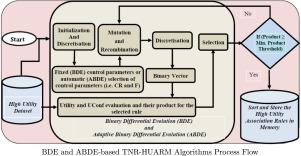Engineering Applications of Artificial Intelligence ( IF 8 ) Pub Date : 2020-09-18 , DOI: 10.1016/j.engappai.2020.103935 Gutha Jaya Krishna , Vadlamani Ravi

|
In this paper, in a first-of-its-kind-study a Binary Differential Evolution (BDE) and an Adaptive Binary Differential Evolution (ABDE)-based top non-redundant high utility association rule mining (TNR-HUARM) algorithms are proposed. A real-life OnlineRetail dataset is analyzed as an application of TNR-HUARM for customer segmentation based on value, i.e. utility. Apart from this dataset, also tested the effectiveness of our proposed models on six high utility benchmark datasets. The results show that BDE based TNR-HUARM numerically outperformed ABDE based TNR-HUARM on all seven datasets. But, when a t-test is performed, it turned out that the null hypothesis is not rejected. Therefore, Differential Evolution and Adaptive Differential Evolution based rule miners are found to be statistically equal in six out of seven datasets. The proposed algorithms were compared against two state-of-the-art algorithms and mixed results were obtained.
中文翻译:

使用二元差分进化挖掘顶级高实用性关联规则
本文首先研究了二进制差分进化(BDE)和基于自适应二进制差分进化(ABDE)的顶级非冗余高效关联规则挖掘(TNR-HUARM)算法。实际的OnlineRetail数据集作为TNR-HUARM在基于价值(即效用)的客户细分中的应用进行了分析。除此数据集外,还在六个高实用性基准数据集上测试了我们提出的模型的有效性。结果表明,在所有七个数据集上,基于BDE的TNR-HUARM在数值上均优于基于ABDE的TNR-HUARM。但是,当执行t检验时,事实证明原假设未被拒绝。因此,在七个数据集中的六个数据集中,发现基于差异进化和自适应差异进化的规则挖掘器在统计上相等。



























 京公网安备 11010802027423号
京公网安备 11010802027423号